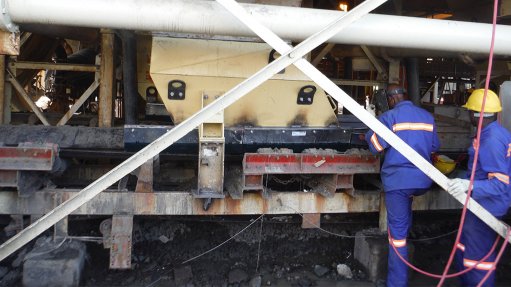
A trend on many mines to cut maintenance costs has sometimes led to general contractors being engaged to conduct repairs and servicing; this is generally not a good idea for specialised equipment, warns Mark Baller, managing director of Weba Chute Systems.
“Most customers are well aware that good maintenance is the right long term solution to preserve the value of their assets and ensure smooth operations,” says Baller. “Faced with financial pressure, however, outsourcing to general contractors is seen as a cheaper option, which it is actually not.”
The danger is that these service providers are not that knowledgeable about the specific products they are maintaining, he says. In many cases, for instance, they see the Weba Chute simply as platework, and conduct repairs in a fairly haphazard way through welding.
“What they don’t realise is that our chutes are custom engineered to meet the specific operational requirements of that mine, so the material chosen and the particular configurations of the transfer points cannot be changed willy-nilly by the incorrect installation of parts or components,” he says.
When maintenance is not conducted in line with the equipment design, this affects the performance of the chute, and ultimately has a knock-on effect on the whole materials handling process of which it is a critical part.
“This will often result in additional costs being incurred by the customer,” he says. “Operationally, there may be added impact and damage to the conveyor belts, or more spillage at the transfer point which requires added clean-up time. Also, dust emissions may increase, and these would have to be addressed.”
The eventual result of incorrect maintenance is that the unit becomes irreparable and has to be replaced. This introduces capital cost implications, on top of the operational and maintenance costs.
“So it is not difficult to see that it can be very dangerous to put the maintenance in the hands of a service provider that is not correctly trained or is not sufficiently knowledgeable,” says Baller. “By trying to save a little – say, R20,000 to R30,000 a month – on the maintenance cost, some mines put their whole operation in jeopardy. Even a single hour of lost production can cost the operation hundreds of thousands of rands in foregone revenue.”
The quality of maintenance, he says, has a direct impact on plant availability. In a recent case, Weba Chute Systems had collaborated on maintenance with a customer to keep their plant availability at between 96% and 98%. When a cost saving exercise led to a general contractor being engaged, the plant availability dropped to 89% – a significant drop that cost the mine substantially in terms of lost production.
“It wasn’t just our equipment that was affected,” says Baller. “All the OEMs were shifted off site in favour of the general contractor. Their drop in productivity was therefore not limited to just the chutes, but extended to a range of other specialised equipment.
Without sufficient training on all the equipment, the contractor could not keep up the required standards, leading to this drastic reduction in plant performance and overall production.”
On the other hand, Baller says, there are a range of benefits that an OEM brings to a mining operation, that turn their maintenance charges into tangible value for the customer.
“In some cases, we have maintenance contracts which actually involve our own crews on site, who perform inspections and conduct the maintenance work,” he says. “The mine will order the spares when they are required, and we work hand-in-hand with the mine’s maintenance superintendents and engineers to schedule the maintenance on these plants.”
He says that Weba Chute Systems also have customers doing their own maintenance. “We assist them with random inspections, just to keep an eye on things, but they generally do their own planning and installation, as well as the ordering of spares,” says Baller.